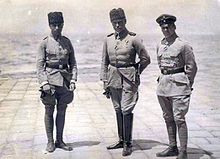
The Battle of Megiddo, also known in Turkish as the Nablus Hezimeti or the Nablus Yarması, was fought between 19 and 25 September 1918, on the Plain of Sharon, in front of Tulkarm, Tabsor and Arara in the Judean Hills as well as on the Esdralon Plain at Nazareth, Afulah, Beisan, Jenin and Samakh. Its name, which has been described as "perhaps misleading" since very limited fighting took place near Tel Megiddo, was chosen by Allenby for its biblical and symbolic resonance.
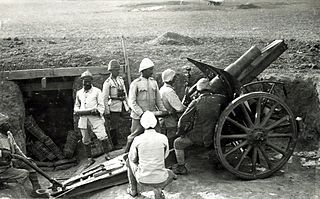
The Sinai and Palestine campaign was part of the Middle Eastern theatre of World War I, taking place between January 1915 and October 1918. The British Empire, the French Third Republic, and the Kingdom of Italy fought alongside the Arab Revolt in opposition to the Ottoman Empire, the German Empire, and the Austro-Hungarian Empire. It started with an Ottoman attempt at raiding the Suez Canal in 1915 and ended with the Armistice of Mudros in 1918, leading to the cession of Ottoman Syria.

The Battle of Jerusalem occurred during the British Empire's "Jerusalem Operations" against the Ottoman Empire, in World War I, when fighting for the city developed from 17 November, continuing after the surrender until 30 December 1917, to secure the final objective of the Southern Palestine Offensive during the Sinai and Palestine Campaign of World War I. Before Jerusalem could be secured, two battles were recognised by the British as being fought in the Judean Hills to the north and east of the Hebron–Junction Station line. These were the Battle of Nebi Samwill from 17 to 24 November and the Defence of Jerusalem from 26 to 30 December 1917. They also recognised within these Jerusalem Operations, the successful second attempt on 21 and 22 December 1917 to advance across the Nahr el Auja, as the Battle of Jaffa, although Jaffa had been occupied as a consequence of the Battle of Mughar Ridge on 16 November.

The Battle of Mughar Ridge, officially known by the British as the action of El Mughar, took place on 13 November 1917 during the Pursuit phase of the Southern Palestine Offensive of the Sinai and Palestine Campaign in the First World War. Fighting between the advancing Egyptian Expeditionary Force (EEF) and the retreating Yildirim Army Group, occurred after the Battle of Beersheba and the Third Battle of Gaza. Operations occurred over an extensive area north of the Gaza to Beersheba line and west of the road from Beersheba to Jerusalem via Hebron.
The Battle of Arara took place on 19 September 1918 during the Battle of Sharon, which along with the Battle of Nablus formed the set piece Battle of Megiddo fought between 19 and 25 September in the last months of the Sinai and Palestine Campaign of the First World War. During the infantry phase of the Battle of Sharon the British Empire 60th Division, XXI Corps attacked and captured the section of the front line nearest the Mediterranean coast under cover of an intense artillery barrage including a creeping barrage and naval gunfire while the 3rd (Lahore), 7th (Meerut) and 75th Divisions XXI Corps attacked the Tabsor group of trenches. These Egyptian Expeditionary Force (EEF) victories over the entrenched Ottoman Eighth Army, composed of German and Ottoman soldiers, began the Final Offensive, ultimately resulting in the destruction of the equivalent of one Ottoman army, the retreat of what remained of two others, and the capture of many thousands of prisoners and many miles of territory from the Judean Hills to the border of modern-day Turkey. After the end of the battle of Megiddo, the Desert Mounted Corps pursued the retreating soldiers to Damascus, six days later. By the time an Armistice of Mudros was signed between the Allies and the Ottoman Empire five weeks later, Aleppo had been captured.

The Battle of Haifa was fought on 23 September 1918 towards the end of the Battle of Sharon which together with the Battle of Nablus formed the set piece Battle of Megiddo fought between 19 and 25 September during the last months of the Sinai and Palestine Campaign of the First World War. During the Battle of Haifa, the Indian 15th Cavalry Brigade, 5th Cavalry Division and part of the Desert Mounted Corps attacked rearguard forces of the Ottoman Empire that resulted in the capture of the towns of Haifa and Acre. This attack took place at the north western edge of the Esdraelon Plain, 40–50 miles (64–80 km) from Sharon.

The Battle of Tell 'Asur, also known as the actions of Tel Asur or the Battle of Turmus 'Aya, took place 8–12 March 1918, after the decisive victory at the Battle of Jerusalem and the Capture of Jericho during the Sinai and Palestine Campaign of World War I. Fighting took place over an area which extended from the Mediterranean to Abu Tellul and Mussalabeh on the edge of the Jordan Valley.
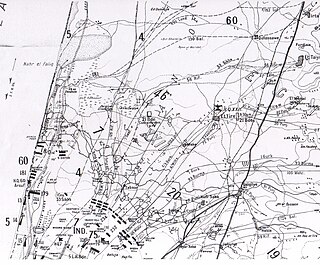
The Battle of Sharon fought between 19 and 25 September 1918, began the set piece Battle of Megiddo half a day before the Battle of Nablus, in which large formations engaged and responded to movements by the opposition, according to pre-existing plans, in the last months of the Sinai and Palestine Campaign of World War I. The fighting took place over a wide area from the Mediterranean Sea east to the Rafat salient in the Judean Hills. Here the Egyptian Expeditionary Force (EEF) XXI Corps with the French brigade sized Détachement Français de Palestine et de Syrie attacked the Yildirim Army Group Eighth Army's XXII Corps and German Asia Corps. The Battle of Sharon extended well behind the Ottoman front lines when the Desert Mounted Corps rode through a gap in the front line across the Plain of Sharon to occupy the Esdraelon Plain. Meanwhile, during the Battle of Nablus the XX Corps attacked Nablus while Chaytor's Force held the right flank in the Jordan Valley before advancing to secure bridges and fords across the Jordan River, to continue the encirclement the defenders in the Judean Hills. Subsequently, Chaytor's Force advanced against the Fourth Army to capture Es Salt and Amman after the Second Battle of Amman.

The Battle of Samakh was fought on 25 September 1918, during the Battle of Sharon which together with the Battle of Nablus formed the set piece Battle of Megiddo fought from 19 to 25 September 1918, in the last months of the Sinai and Palestine Campaign of the First World War. During the cavalry phase of the Battle of Sharon the Desert Mounted Corps commanded by the Australian Lieutenant General Harry Chauvel, captured the Esdraelon Plain 40–50 miles (64–80 km) behind the front line in the Judean Hills on 20 September, when the 3rd Light Horse Brigade captured Jenin. The 4th Light Horse Brigade, Australian Mounted Division was deployed guarding supply columns, and prisoners, before being ordered to attack and capture Samakh on the shore of the Sea of Gallilee. Here the Ottoman and German garrison had been ordered by the commander of the Yildirim Army Group to fight to the last man.
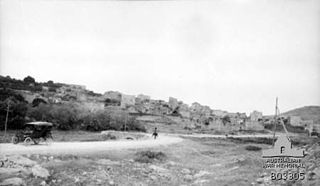
The Battle of Tabsor was fought on 19–20 September 1918 beginning the Battle of Sharon, which along with the Battle of Nablus formed the set piece Battle of Megiddo fought between 19 and 25 September in the last months of the Sinai and Palestine Campaign of the First World War. During the infantry phase of the Battle of Sharon the British Empire 60th Division, XXI Corps attacked and captured the section of the front line nearest the Mediterranean coast under cover of an intense artillery barrage including a creeping barrage and naval gunfire. This Egyptian Expeditionary Force (EEF) victory over the entrenched Ottoman Eighth Army, composed of German and Ottoman soldiers, began the Final Offensive, ultimately resulting in the destruction of the equivalent of one Ottoman army, the retreat of what remained of two others, and the capture of many thousands of prisoners and many miles of territory from the Judean Hills to the border of modern-day Turkey. After the end of the battle of Megiddo, the Desert Mounted Corps pursued the retreating soldiers to Damascus, six days later. By the time the Armistice of Mudros was signed between the Allies and the Ottoman Empire five weeks later, Aleppo had been captured.

The Battle of Nazareth began on 20 September 1918, during the Battle of Sharon, which together with the Battle of Nablus formed the set piece Battle of Megiddo fought during the last months of the Sinai and Palestine Campaign of the First World War. During the cavalry phase of the Battle of Sharon the Desert Mounted Corps rode to the Esdraelon Plain 40 and 50 miles behind the front line in the Judean Hills. At Nazareth on the plain, the 13th Cavalry Brigade of the 5th Cavalry Division attempted to capture the town and the headquarters of the Yildirim Army Group which was eventually captured the following day after the garrison had withdrawn.
The Capture of Afula and Beisan occurred on 20 September 1918, during the Battle of Sharon which together with the Nablus, formed the set piece Battle of Megiddo fought during the last months of the Sinai and Palestine Campaign of the First World War. During the cavalry phase of the Battle of Sharon, the 4th Cavalry Division of the Desert Mounted Corps attacked and captured the main communications hub at Afula, located in the centre of the Esdraelon Plain, and Beisan on the plain's eastern edge near the Jordan River, some 40–50 miles (64–80 km) behind the front line in the Judean Hills.

The Capture of Jenin occurred on 20 September 1918, during the Battle of Sharon which together with the Battle of Nablus formed the set piece Battle of Megiddo fought between 19 and 25 September during the last months of the Sinai and Palestine Campaign of the First World War. During the cavalry phase of the Battle of Sharon carried out by the Desert Mounted Corps, the 3rd Light Horse Brigade, Australian Mounted Division attacked and captured the town of Jenin located on the southern edge of the Esdraelon Plain 40–50 miles (64–80 km) behind the front line in the Judean Hills. The Australian light horse captured about 2,000 prisoners, the main supply base and the ordnance depot of the Seventh and the Eighth Armies in and near the town. They also cut the main road from Nablus and a further 6,000 Ottoman Empire and German Empire prisoners, were subsequently captured as they attempted to retreat away from the Judean Hills.
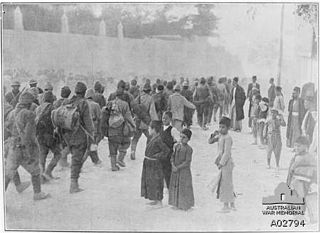
The Battle of Nablus took place, together with the Battle of Sharon during the set piece Battle of Megiddo between 19 and 25 September 1918 in the last months of the Sinai and Palestine Campaign of the First World War. Fighting took place in the Judean Hills where the British Empire's XX Corps attacked the Ottoman Empire's Yildirim Army Group's Seventh Army defending their line in front of Nablus. This battle was also fought on the right flank in the Jordan Valley, where Chaytor's Force attacked and captured the Jordan River crossings, before attacking the Fourth Army at Es Salt and Amman capturing many thousands of prisoners and extensive territory. The Battle of Nablus began half a day after the main Battle of Sharon, which was fought on the Mediterranean section of the front line where the XXI Corps attacked the Eighth Army defending the line in front of Tulkarm and Tabsor and the Desert Mounted Corps which rode north to capture the Esdrealon Plain. Together these two battles, known as the Battle of Megiddo, began the Final Offensive of the war in the Sinai and Palestine campaign.
The Third Transjordan attack by Chaytor's Force, part of the British Empire's Egyptian Expeditionary Force (EEF), took place between 21 and 25 September 1918, against the Ottoman Empire's Fourth Army and other Yildirim Army Group units. These operations took place during the Battle of Nablus, part of the Battle of Megiddo which began on 19 September in the final months of the Sinai and Palestine Campaign of World War I. Fought on the right flank and subsidiary to the Battle of Nablus, the Third Transjordan attack began northwards, with the assault on Kh Fasail. The following day a section of Chaytor's Force, attacked and captured the Ottoman Empire's 53rd Division on the main eastwards line of retreat out of the Judean Hills across the Jordan River. Retreating columns of the Yildirim Army Group were attacked during the battle for the Jisr ed Damieh bridge, and several fords to the south were also captured, closing this line of retreat. Leaving detachments to hold the captured bridge and fords, Chaytor's Force began their eastwards advance by attacking and capturing the Fourth Army garrison at Shunet Nimrin on their way to capture Es Salt for a third time. With the Fourth Army's VIII Corps in retreat, Chaytor's Force continued their advance to attack and capture Amman on 25 September during the Second Battle of Amman. Several days later, to the south of Amman, the Fourth Army's II Corps which had garrisoned the southern Hejaz Railway, surrendered to Chaytor's Force at Ziza, effectively ending military operations in the area.
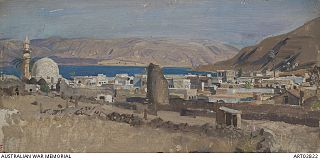
The Capture of Tiberias took place on 25 September 1918 during the Battle of Sharon which together with the Battle of Nablus formed the set piece Battle of Megiddo fought between 19 and 25 September in the last months of the Sinai and Palestine Campaign of the First World War. During the cavalry phase of the Battle of Sharon the Desert Mounted Corps occupied the Esdraelon Plain 40–50 miles (64–80 km) behind the front line in the Judean Hills. One squadron from each of the 3rd and 4th Light Horse Brigades Australian Mounted Division attacked and captured Tiberias, along with the Yildirim Army Group's Ottoman and German garrison.

The Capture of Jisr ed Damieh took place on 22 September 1918 during the Third Transjordan attack of the Battle of Nablus which, along with the main Battle of Sharon formed the Battle of Megiddo fought during the Sinai and Palestine Campaign of the First World War. Units of Chaytor's Force under the commanded by Brigadier-General William Meldrum, and known as "Meldrum's Force", attacked and captured the bridge. This successful attack cut the most direct line of retreat from the Judean Hills for the Seventh and remnants of the Eighth Armies, while units from these two armies were moving towards, and crossing the Jisr ed Damieh bridge over the Jordan River. This victory by Meldrum's Force opened the way for Chaytor's Force to advance along the main Nablus to Es Salt road to capture Es Salt and to continue on to the victory at the Second Battle of Amman.
The Southern Palestine offensive, employing manoeuvre warfare, began on 31 October 1917, with the Battle of Beersheba, during the Sinai and Palestine Campaign, of World War I. After the capture of Beersheba, by the Egyptian Expeditionary Force (EEF), the Gaza to Beersheba line became increasingly weakened and, seven days later, the EEF successfully forced the Ottoman Turkish Empire's Seventh and Eighth Armies to withdraw. During the following seven days of pursuit, the Turkish forces were pushed back to Jaffa. There followed three weeks of hard fighting in the Judean Hills before Jerusalem was captured on 9 December 1917. During five and a half weeks of almost continuous offensive operations, the EEF captured 47.5 miles (76.4 km) of territory.

The Battle of Hareira and Sheria was fought on 6–7 November 1917 when the Egyptian Expeditionary Force attacked and captured the Yildirim Army Group's defensive systems protecting Hareira and Sheria in the centre of the Gaza to Beersheba line, during the Southern Palestine Offensive of the Sinai and Palestine Campaign in World War I.
The Capture of Wadi el Hesi and the associated Sausage Ridge, began during the evening of 7 November 1917, was fiercely fought for during 8 November and not cleared until the early hours of 9 November, at the beginning of the pursuit phase of the Southern Palestine Offensive in the Sinai and Palestine Campaign during World War I. The advancing British Empire units of the Egyptian Expeditionary Force (EEF) were held by rearguard units of the withdrawing Ottoman Empire units of the Yildirim Army Group, holding a strategically strong position to the north of Gaza.



